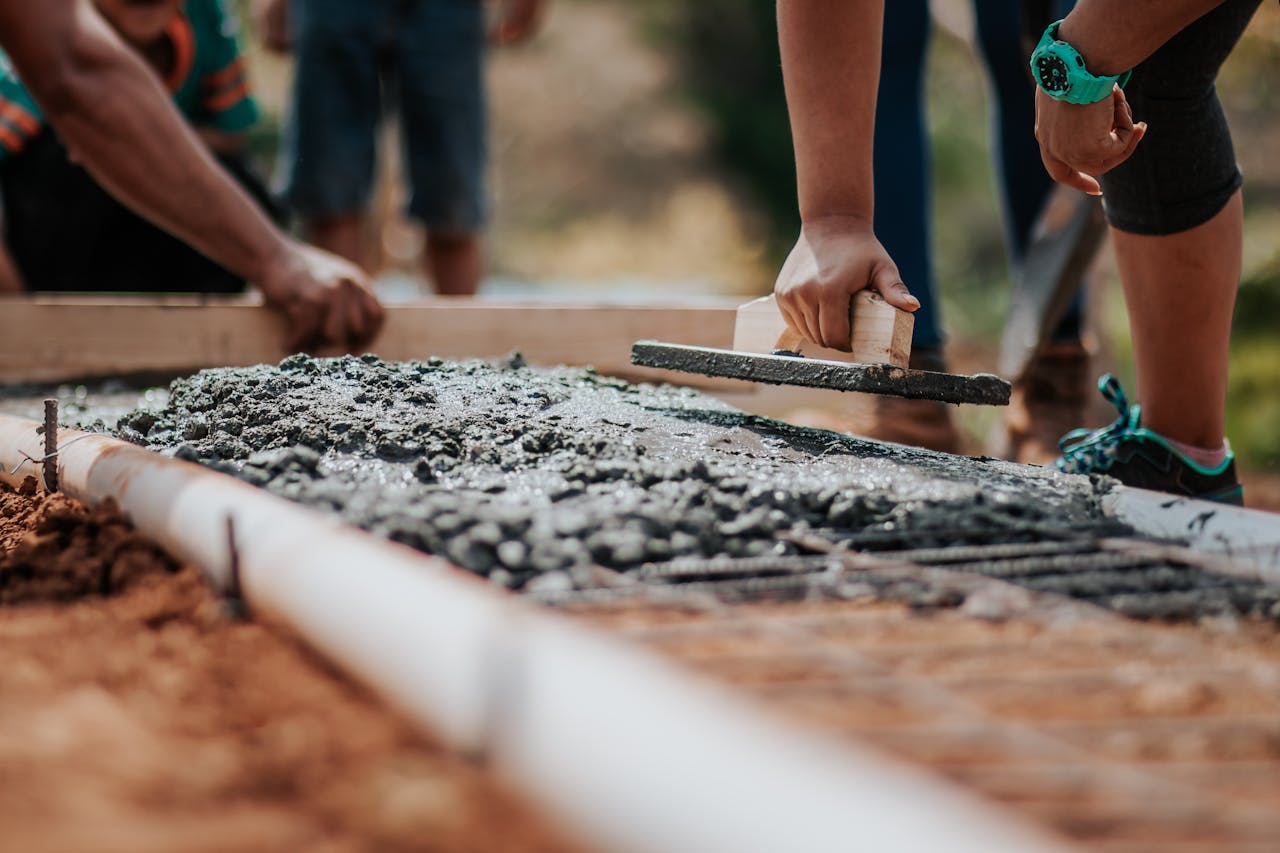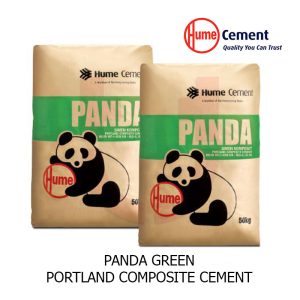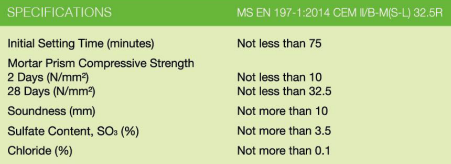- ALFRAN - OUR HOUSE BRAND
- Pipes
- Fittings
- Valves
- SOLAR PV SYSTEM
- Accessories
- Building Materials
- KITCHEN SERIES
- BATHROOM SERIES
- OTHERS - NON BUILDING MATERIALS
Portland Composite Cement (PCC) – An Overview (+ FREE Quotation)
April, 14 2024
Author: Unitrade
Share This With

Portland Composite Cement (PCC) is a technologically advanced cementitious composite, blending Portland cement clinker with supplementary cementitious materials (SCMs) like fly ash, slag, and silica fume, along with calcium sulfate for setting-time adjustments. This composition enhances concrete’s mechanical properties, sustainability, and durability, while reducing the environmental impact of cement production.
This article focuses on PCC’s formulation, benefits, and its contribution towards sustainable construction, highlighting the reduction in CO2 emissions through decreased clinker usage.
What is Portland Composite Cement?
Portland Composite Cement (PCC) is a type of blended cement that combines Portland cement clinker with other cementitious materials, such as pozzolanic materials (e.g., volcanic ash, fly ash, silica fume), limestone, and gypsum. These additional components enhance the properties of the cement, offering improvements in terms of durability, workability, and sustainability compared to ordinary Portland cement (OPC).

The inclusion of supplementary cementitious materials (SCMs) in PCC reduces the amount of clinker required, which in turn lowers the carbon footprint associated with cement production. SCMs contribute to the final properties of the cement by reacting with the calcium hydroxide released during the hydration of Portland cement, forming additional cementitious compounds that can improve strength and durability.

PCC is designed to offer a balanced performance for a wide range of construction applications. It is particularly valued for its environmental benefits, as the reduction in clinker content decreases CO2 emissions. Additionally, the use of SCMs can enhance specific characteristics of the concrete, such as resistance to sulfate attack, chloride ingress, and alkali-silica reaction, making PCC a versatile choice for various construction needs, including buildings, bridges, and infrastructure projects.
Blending Materials of Portland Composite Cement
The basic ingredient of PCC, Portland cement clinker, is combined with waste materials like fly ash, transforming them into valuable components of a building material. Calcium sulfate is added to regulate the setting time, while calcium silicate and calcium silicate hydrate contribute to the cement’s strength and structural integrity of concrete structures.
Fly Ash
Fly ash is a byproduct of coal combustion in power plants. It’s rich in silica and alumina, making it a valuable pozzolanic material. When mixed with lime (calcium hydroxide), fly ash reacts to form additional cementitious compounds, improving the concrete’s strength and durability. It also reduces the permeability of concrete, enhancing its resistance to sulfate attack and chloride ingress.
Slag
Slag is a byproduct of iron and steel manufacturing. Granulated blast furnace slag (GBFS), when ground into a fine powder, acts as a hydraulic material, meaning it can react with water to form cementitious compounds similar to those produced by Portland cement. Slag can significantly improve the workability of concrete and increase its resistance to aggressive chemicals.
Silica Fume
Silica fume is a byproduct of producing silicon metal or ferrosilicon alloys. Consisting of very fine particles of amorphous silicon dioxide, it has a high pozzolanic activity. Silica fume can greatly increase the strength and density of concrete, making it particularly useful in high-performance and high-strength concrete applications.
Limestone
Finely ground limestone can be added to PCC as a filler or as an active ingredient when it reacts with the aluminate phases in the cement. It contributes to the cement’s early strength development and improves workability. The inclusion of limestone also allows for a reduction in clinker content, which in turn lowers the CO2 emissions associated with cement production.
Natural Pozzolans
Natural pozzolans include volcanic ash, calcined clay, and other natural materials containing reactive silica. Like fly ash and silica fume, they react with lime to form additional cementitious compounds, contributing to the concrete’s strength and durability while improving its resistance to chemical attack.
These materials are carefully selected and blended to create a unique composition that not only enhances the strength and durability of structures but also endows PCC with superior workability, consistency, cohesiveness, and ease of mixing, enriching the construction process and ensuring a richer mix.
Clinker
Clinker production is a crucial phase in the manufacture of Portland cement and plays a significant role in the overall process of producing Portland Composite Cement (PCC).
Raw Materials
The primary raw materials for clinker production include limestone (calcium carbonate), along with smaller quantities of materials like clay or shale (sources of silicon, aluminum, and iron). These materials are carefully blended to achieve a precise chemical composition necessary for the clinker formation process.
Preparation
Before being fed into the kiln, the raw materials are crushed and then ground into a fine powder, typically in a raw mill. This powder is then mixed and preheated to start the chemical reactions that will occur in the kiln.
Kiln Phase
The core of clinker production takes place in the kiln, a large, rotating furnace. The preheated raw material mix is fed into the kiln, where it reaches temperatures up to 1450°C. At these high temperatures, a series of chemical reactions occur, leading to the formation of new compounds. The key reaction is the decarbonation of limestone (calcium carbonate), which releases CO2 and leaves calcium oxide (lime). The lime then reacts with silica, alumina, and iron oxides to form clinker minerals, primarily alite (C3S), belite (C2S), aluminate (C3A), and ferrite (C4AF).
Cooling and Final Processing
After the material exits the kiln, it is rapidly cooled to preserve the newly formed clinker minerals in a reactive state. The cooling process is crucial for the material’s final properties and performance. Once cooled, the clinker is mixed with gypsum (to control the setting time of cement) and other materials depending on the specific type of cement being produced. For Portland Composite Cement, this includes mixing with pozzolanic materials, limestone, and other additives.
Advantages of Portland Composite Cement
Portland Composite Cement offers a range of performance characteristics that make it suitable for various construction applications, balancing durability, sustainability, and workability. These characteristics are derived from the unique combination of Portland cement clinker and supplementary cementitious materials (SCMs) such as fly ash, slag, silica fume, and natural pozzolans. Here’s a closer look at the key performance characteristics of Portland Composite Cement:
Enhanced Durability
Portland Composite Cement demonstrates increased durability compared to Ordinary Portland Cement due to its lower permeability and improved resistance to chemical attacks. The SCMs in Portland Composite Cement react with calcium hydroxide to form additional cementitious compounds, which fill the pores in concrete, making it denser and more resistant to the ingress of harmful substances like chlorides, sulfates, and carbon dioxide. This enhanced durability is particularly beneficial in environments prone to chemical aggression or where longevity and minimal maintenance are desired.
Improved Workability
The addition of SCMs to Portland Composite Cement can improve the workability of fresh concrete. Certain SCMs, like fly ash and finely ground slag, have particle sizes that help in optimizing the packing density of the cementitious materials, leading to a more workable mix that is easier to place and finish. This can reduce the need for water and admixtures, further enhancing the concrete’s properties.
Lower Heat of Hydration
Portland Composite Cement typically generates less heat during the hydration process than Ordinary Portland Cement, primarily due to the slower reaction rate of the SCMs. This characteristic makes Portland Composite Cement an excellent choice for mass concrete pours, where controlling the temperature rise is critical to preventing thermal cracking. The lower heat of hydration contributes to a more uniform and controlled setting of the concrete, ensuring structural integrity.
Reduced Environmental Impact
One of the most significant advantages of Portland Composite Cement is its reduced carbon footprint. By substituting a portion of the clinker with SCMs, which are often industrial byproducts, the overall CO2 emissions associated with cement production are lowered.
By incorporating materials like calcium aluminate hydrate and utilizing cement with fly ash, PCC not only leverages the beneficial properties of these components but also contributes to waste reduction. The efficient cement production process, aimed at reducing the mass of cement required for construction projects, aligns with the goals of energy saving and minimizing the carbon footprint of the cement industry.
Versatility in Applications
Portland Composite Cement is suitable for a wide range of construction applications, from residential buildings to infrastructure projects. Its versatility is attributed to its balanced properties, which can be adjusted by varying the types and proportions of SCMs used. This allows for the customization of the cement to meet specific requirements, such as increased resistance to sulfates for use in marine environments or enhanced early strength for fast-paced construction projects.
Improved Long-Term Strength
While the initial strength development of Portland Composite Cement might be slower than that of Ordinary Portland Cement, the long-term strength, particularly beyond 28 days, can be higher. The pozzolanic reactions and the continued hydration of SCMs contribute to the strength gain over time, offering structures that are robust and have a prolonged service life.
Portland Composite Cement Standards
Adherence to the national standard and guidelines from cement associations, like the Portland Cement Association, ensures the quality and safety of Portland Composite Cement. For example, ASTM C150, EN 197, and CSA A3000-08. These standards and associations guide the cement manufacturing capacity and practices, ensuring efficient cement production processes that meet or exceed industry benchmarks.
ASTM C150
ASTM C150 is a standard specification established by the American Society for Testing and Materials (now ASTM International). It specifies the chemical and physical requirements for hydraulic cement, which is primarily used in the construction industry. Although ASTM C150 is most commonly associated with Ordinary Portland Cement (OPC), it sets a benchmark for the quality and properties of cement, including aspects like setting time, fineness, strength, and heat of hydration. While ASTM C150 focuses on OPC, the principles of consistent quality and performance are relevant to the manufacturing and application of Portland Composite Cement as well.
EN 197 norm
EN 197 is a series of standards developed by the European Committee for Standardization (CEN) that define and regulate the composition, specifications, and conformity criteria for common cements, including Portland Composite Cement. EN 197-1, in particular, categorizes cements into various types based on their composition (such as CEM I for OPC and CEM II for Portland Composite Cement) and specifies requirements for their physical and chemical properties. This standard is crucial for ensuring the quality of Portland Composite Cement in the European market, focusing on aspects like strength development, durability, and environmental impact.
CSA A3000-08
CSA A3000 is a Canadian standard developed by the Canadian Standards Association (now known as CSA Group) for hydraulic cements, including Portland Composite Cement. The “08” in A3000-08 refers to the edition of the standard, indicating that it was published in 2008. This comprehensive standard covers the specifications for different types of cements used in Canada, including their chemical and physical properties, performance requirements, and testing methods. It ensures that cements meet the necessary criteria for use in various construction applications, emphasizing quality, durability, and suitability for specific environmental conditions.
Health Implications of Portland Composite Cement Exposure
Exposure to airborne particulates of Portland Composite Cement (PCC) during handling and mixing processes poses a risk of pulmonary afflictions. The inhalation of fine dust can lead to the development of silicosis, aggravate conditions such as asthma, and contribute to the onset of chronic obstructive pulmonary disease (COPD), necessitating stringent occupational safety measures.
Dermatological Effects
The alkaline nature of PCC, coupled with the presence of hexavalent chromium, can induce adverse dermatological reactions upon direct contact. These reactions range from mild irritations to more severe forms of cement dermatitis, highlighting the need for protective skin coverage during cement handling operations.
Environmental Implications of Portland Composite Cement
While the incorporation of supplementary cementitious materials in PCC mitigates the overall carbon footprint relative to traditional cement formulations, the manufacturing process remains a substantial source of CO2 emissions. The calcination phase, integral to clinker production, is particularly carbon-intensive, underscoring the ongoing challenge of reducing the construction industry’s environmental impact.
Resource Extraction Impact
The procurement of raw materials for Portland Composite Cement, including the extraction of limestone and the derivation of supplementary components, carries ecological consequences. The demand for these materials can lead to the depletion of natural resources and adversely affect local ecosystems, pressing the need for sustainable resource management practices within the industry.
Conclusion
The use of PCC as a building material, especially in contact with soil or in structures exposed to harsh environments, showcases its adaptability and resilience. This 136-year-old cement technology has evolved into an artificial cement that harnesses the properties of its components to meet the demands of modern construction.
Portland Composite Cement exemplifies the shift towards more sustainable building materials. By blending traditional and innovative materials, such as combustible material or organic compounds, it offers a solution that balances performance with environmental stewardship. The cement works precinct, with its concentration of cement manufacturing, stands as a testament to the industry’s commitment to advancing cement technology and production practices.
Trust UNITRADE to supply your PCC and cement mix. For the past 40 years, we’ve been Malaysia’s leading construction materials supplier for renowned projects such as KLCC, KLIA, and most major highways in Klang Valley. Check out our diverse catalogue of products and ensure your building or plumbing project’s success!
-
Category
Uncategorized -
Tags
Portland Composite Cement (PCC) – An Overview (+ FREE Quotation)
Read morenewsletter Subscription
Sign Up Now & Stay Tune With Our Latest News & Product Updates!
